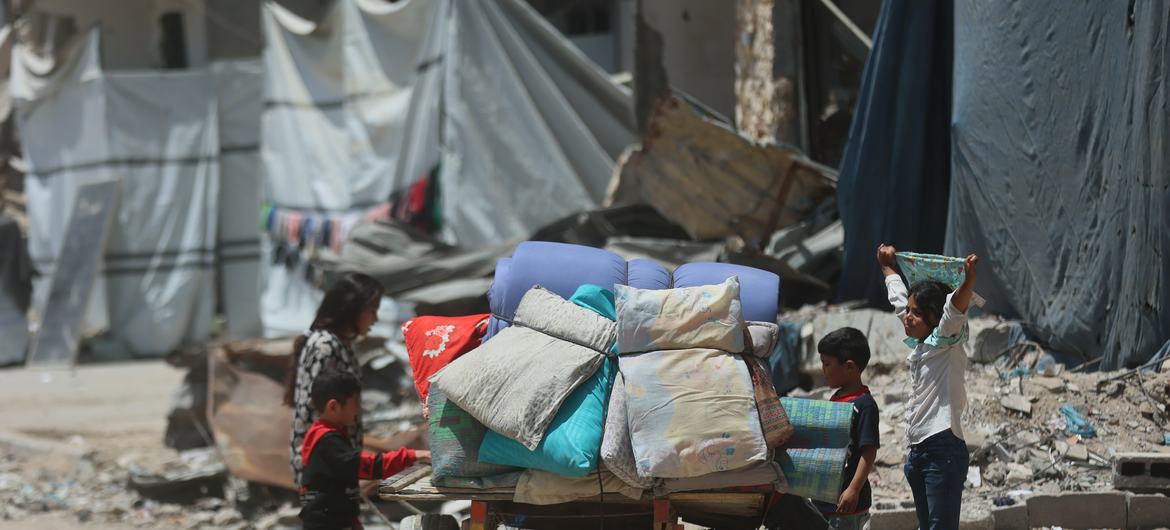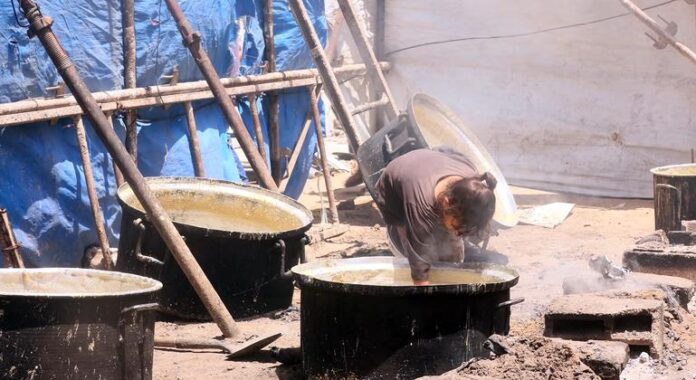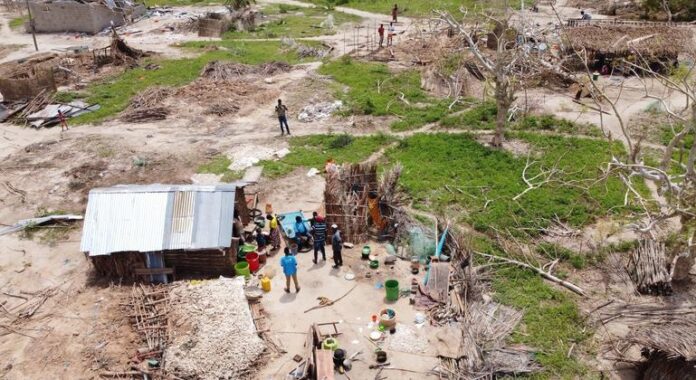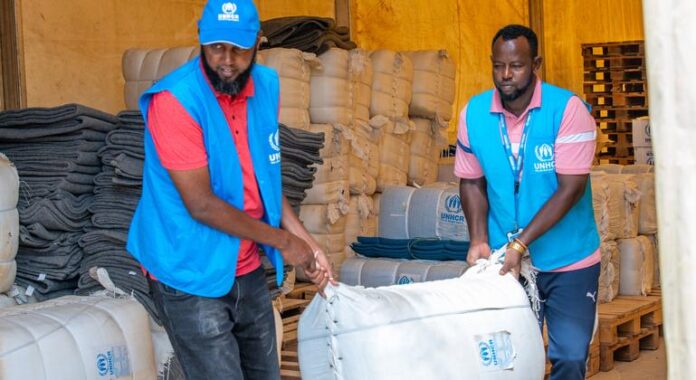“There’s been so much time wasted talking about the various proposals and the various plans. In the meantime, people are dying and are left without aid,” Olga Cherevko said in an exclusive interview with UN News.
This week, UN agencies were able to bring limited amounts of food, flour and other items into Gaza after Israel lifted a nearly three-month aid blockade.
Ms. Cherevko said humanitarians were told this was a temporary measure until aid distribution is implemented through the so-called Gaza Humanitarian Foundation, an initiative backed by Israel and the United States.
The plan sees aid dispersed from four points south of the Netzarim Corridor, which is under Israeli military control, and involves the use of private US contractors.
She discussed this development, the positive impact of the trickle of aid allowed into Gaza, and the need to scale up efforts.
“There is a sense that some people feel like this is the end and that there is no turning back – and that they are just waiting to die,” she said.
This interview has been edited for length and clarity
Olga Cherevko: We’ve been speaking about this and other proposals and plans. Our concerns are that any distribution of aid, any system that exists, needs to be in line with globally established humanitarian principles. And if it isn’t, it’s not something that we can be involved in.
We have concerns about the scalability of this proposed plan, and about various other parts of it.
The biggest issue is that we have a plan, and we have a system that we are using as we speak, and the system has been tried over various crises across the world. It has been proven to work, it has mechanisms to mitigate theft, to mitigate diversion and it ensures that it reaches people wherever they are.
So, there’s been so much time wasted talking about the various proposals and the various plans. In the meantime, people are dying and are left without aid.
The volume of aid is literally a drop in the ocean of what is needed
UN News: The UN definitely will not be taking part in this plan, but did you receive any indications that you will be able to proceed with the work that you’ve been doing over the past couple of days?
Olga Cherevko: For the time being it’s unclear because obviously the resumption of limited volumes of aid entering that the Israeli authorities have approved as of a few days ago, we were obviously assured that we would be using our mechanisms – so the ones that were using now, the ones that are already in place.
We were informed that this would be an interim measure until this Foundation starts working. At this point, we really don’t have more details and again, it will have to be seen on the ground how things will develop.
Al-Banna Bakery resumes bread production after more than 40 days of waiting for a flour delivery in Deir al-Balah, central Gaza Strip.
UN News: Were any trucks allowed in today and was more aid distributed?
Olga Cherevko: There have been batches of trucks coming in since this decision to allow them was approved. We have already been able to get some of the aid to the people in need, including getting flour to bakeries, and a number of bakeries have resumed their operations and fired up their ovens.
We also had some partners who picked up the bread for direct distribution. A field hospital also received a batch of medical supplies.
These are obviously very positive steps and positive developments in the right direction, but the volume of this aid is literally a drop in the ocean compared to the extent of needs on the ground.
UN News: We heard that most, if not all, of the supplies that were allowed in yesterday were nutritional and food aid. Is this a new development that some medical supplies were allowed in today? How many people can be served with these food items and medical supplies?
Olga Cherevko: The medical supplies were always part of the agreement to be included. But again, this is something that in itself is limiting because at the moment what is being allowed is things like nutrition, flour, some medicines and a few other things. It has to be a full range of things for us to be able to really deliver assistance at scale.
In terms of how many people it will serve, you can compare the kind of volumes that we were having during the ceasefire to what we have now and you will see that it’s woefully insufficient. But we have enough food alone to feed people for several months waiting at the crossings.
UN News: The World Food Programme (WFP) said 15 of its trucks were looted. Can you tell us what’s being done to prevent looting?
Olga Cherevko: Regarding looting and break-ins or whatever to try to divert or take aid – if you look at the numbers of these kinds of incidents before the ceasefire and during the ceasefire you will see a huge change.
There were barely any such incidents during the weeks of the ceasefire when we were able to bring in these large volumes (of aid).
When the ceasefire broke down and the crossings were closed for the entry of any cargo, and we got to the point where we were really in a desperate situation and we were running low on everything, that is when they started again.
UN News: Let’s go back to the Gaza Humanitarian Foundation. As the four distribution points are going to be south of the Netzarim Corridor – reportedly one in Middle Gaza and the others in the south – are you already starting to see movements towards those areas? What are your concerns about displacement?
People are sleeping in the streets because there’s nowhere for them to go
Olga Cherevko: Our concerns about displacement are what they have always been. Obviously, we would never support any sort of forced displacement, or any type of ethnic cleansing, or anything that would forcibly drive people from the areas where they are.
Before the ceasefire, more than 90 per cent of people were forcibly displaced across Gaza and they were being squeezed into an increasingly smaller piece of land. When the ceasefire happened a lot of them went back.
They tried to restart their lives and they kind of had a bit of time to process what’s been happening. When the ceasefire broke down again on 18 March, we saw another 610,000 people displaced again. These types of displacement are getting more and more dangerous and desperate because people are coming with nothing. People are fleeing with just the shirt on their back.
We’re now hearing and seeing people sleeping in the streets because there’s nowhere for them to go. As we’ve said time and time again, there is no safe place in Gaza, and this has been proven time and time again.

Children of a displaced family in Gaza City gather around a cart carrying their belongings.
UN News: You’ve been back and forth to Gaza for quite some time now, and you’ve seen the suffering first-hand. Can you give our audience an idea of what it means in real-life terms when aid is prevented from reaching those in need?
Olga Cherevko: Something that has always stuck me about the Palestinians in Gaza is their resilience and their strength, and the spirit that they have kept throughout these months of war.
I knew Gaza well before because I used to work there for several years starting from 2014, and knowing how people have endured so much suffering and despite that they find the strength to go, they find the strength to smile at you and to offer you tea or anything that they might still have.
Now when I speak to people, the thing that is most devastating is that there is a sense that some people feel like this is the end and that there is no turning back and that they are just waiting to die.
Before this limited aid was allowed to enter, the remaining operating community kitchens would have hundreds of people huddled around them waiting for hours with empty pots.
Many were told to turn back because there’s no food for them. People were telling me that they weren’t eating for several days at a time. I saw children that are being malnourished, and suffering from malnutrition.
These kinds of things are very preventable, and preventable deaths are happening all around us because of this intentional crisis imposed on Gaza by closing the crossings.
And that is the most frustrating thing for me – knowing that we can quickly address these issues if only we were given the opportunity – because we have everything waiting outside of Gaza to come in.







